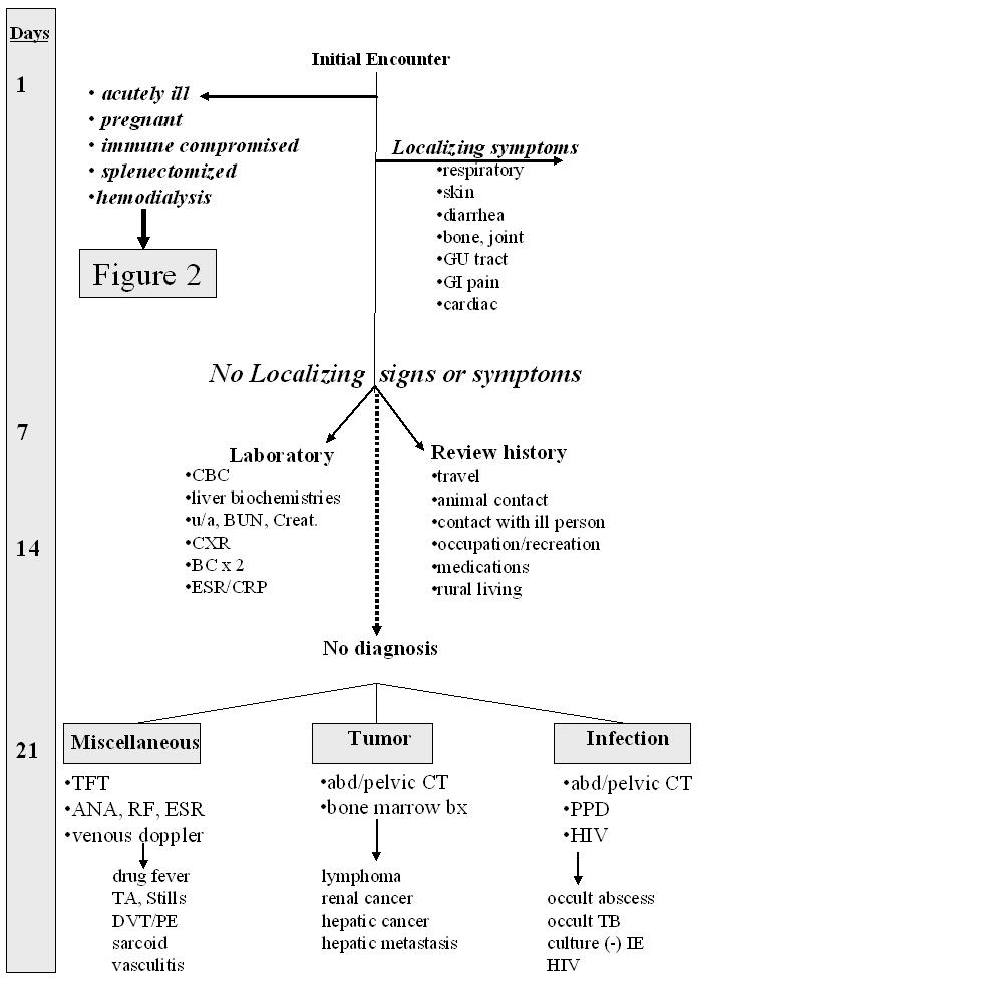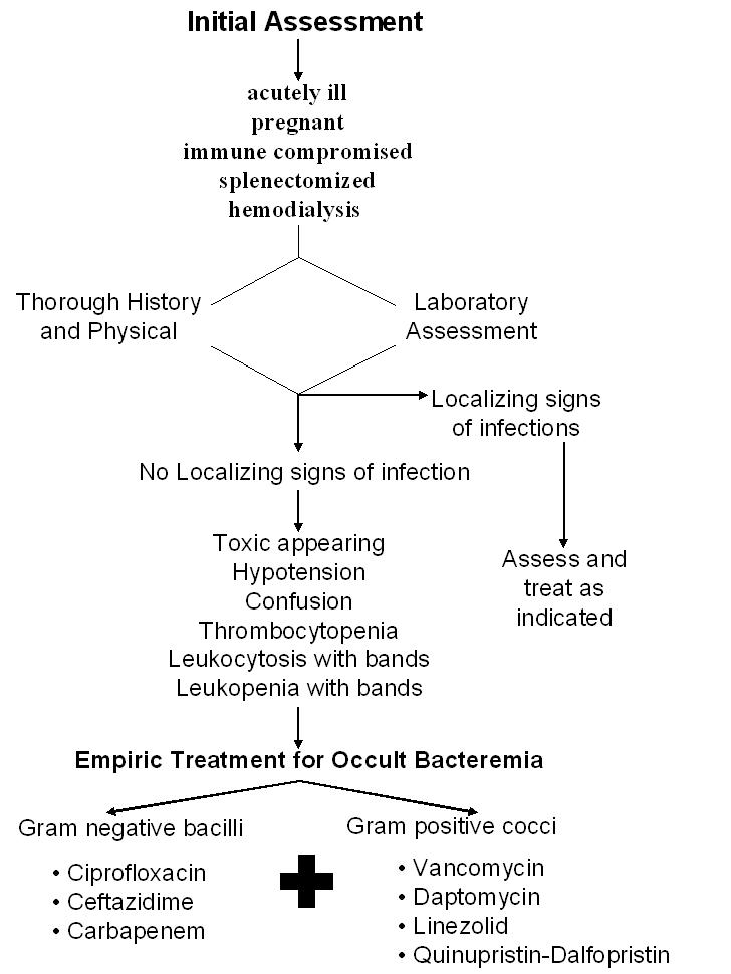
Figure 1: Approach to the Febrile Patient
The evaluation of the febrile patient is paced according to severity of symptoms, underlying illnesses and results of history, physical exam and laboratory assessment. It should proceed in a stepwise fashion from non-invasive inexpensive testing to the more complex evaluation frequently needed in the evaluation of the patient with FUO. The acutely ill or immune compromised patient, pregnant women, and the patient receiving dialysis or living in a nursing home should receive a more in-depth initial investigation. The shaded box on the left side represents the number of febrile days.
ICH= immune compromised host, IE= infective endocarditis, CXR=chest x-ray, CAT=computer assisted tomography, TB=tuberculosis, TFT=thyroid function tests, DVT=deep venous thrombosis, PE= pulmonary embolism, TA=temporal arteritis, GI=gastrointestinal, GU=genitourinary, BC=blood culture, u/a=urinalysis, CA=cancer, CBC=complete blood count. Adapted form Marcel Dekker Inc in Medical Management of Infectious Diseases, Ed C Grace, 2003.

Figure 2: Empiric Antibiotics for Ill Appearing Patient at Risk for Occult Bacteremia

Table 1: Infections That May Present Non-focally |
|
HAV= hepatitis A virus, HBV = hepatitis B virus, HCV = hepatitis C virus, CMV = cytomegalovirus,
EBV = Epstein Barr Virus, HIV = human immunodeficiency virus
|
Table 2: Non-infectious Illnesses That May Present with Fever |
|
AML = acute myelogenous leukemia, SLE = systemic lupus erythematosus
Table 3: Drugs That Can Cause Fever |
||
Antimicrobial
|
Cardiovascular
|
Central nervous system
|
Anti-inflammatory
|
||
Anti-neoplastic
|
Miscellaneous
|
|
*bolded drugs are the most common causes of drug fever
Used with permission by Marcel Dekker Inc in Medical Management of Infectious Diseases, Ed C Grace, 2003.
|
Table 4: Vasculitis Syndromes |
||||
Syndrome |
Population at risk |
Symptoms |
Organs involved |
Laboratory assessment |
|
Polyarteritis nodosa |
middle-aged men>women |
fever, wt loss, rash, abdominal pain, arthralgia |
kidneys, GI tract, skin, peripheral nerves |
leukocytosis anemia, ↑ESR, p-ANCA, HbsAg, U/A |
|
Churg-Strauss
|
middle-aged men>women |
fever, wt loss, rash, asthma |
lungs, skin, peripheral nerves |
eosinophilia, p-ANCA, abnormal CXR |
|
Wegener’s granulomatosis |
male or female, adolescent to middle aged |
fever, wt loss, nasal ulcers, cough, sinusitis, hemoptysis, arthralgia |
upper and lower respiratory tracts, kidney |
Leukocytosis, anemia, ↑ESR c-ANCA, U/A, abnormal CXR |
|
Takayasu’s arteritis |
young female, more common in Orient |
fever, wt loss, arthralgia, loss of peripheral pulses, pain over vessels |
aortic arch and branches |
arteriography |
|
Henoch Schönlein purpura |
children and young adults |
palpable purpura, arthralgia, abdominal pain, bloody stool |
skin, kidneys, GI tract |
U/A |
|
Essential mixed cryoglobulinemia |
middle aged women |
purpuric lesions, ulcers, arthralgia, Raynaud’s phenomenon |
kidney, skin |
low C3, C4, CH50, U/A, HCV antibody |
Used with permission by Marcel Dekker Inc in Medical Management of Infectious Diseases, Ed C Grace, 2003.
ESR = erythrocyte sedimentation rate, ANCA = antinuclear cytoplasmic antibody, U/A = urinalysis, HbsAg = hepatitis B virus surface antigen, CXR = chest x-ray, GI = gastrointestinal, C = complement, HCV = hepatitis C virus
Table 5: Key Historical Questions |
|
Used with permission by Marcel Dekker Inc in Medical Management of Infectious Diseases, Ed C Grace, 2003.
|
Table 6: Causes of “Classic” FUO by Etiologic Category |
||||
|
Infection |
||||
|
Localized bacterial:
Systemic mycoses:
Endovascular:
|
Systemic bacterial :
|
Viral: Parasitic: |
||
Neoplasm |
||||
|
|
|||
|
Non-Infectious Inflammatory Conditions |
||||
|
|
|
||
|
|
|||
|
|
|||
|
|
|
|
|
|
Used with permission by Marcel Dekker Inc in Medical Management of Infectious Diseases, Ed C Grace, 2003.
CMV = cytomegalovirus, EBV = Epstein Barr Virus, HAV = hepatitis A virus, HBV = hepatitis B virus, HCV = hepatitis C virus, HIV = human immunodeficiency virus, SLE = systemic lupus erythematosus, DVT = deep venous thrombosis, PE = pulmonary embolism
|
Table 7: Causes of “Nosocomial” FUO by Etiologic Category |
|
|
Table 8: Causes of “Neutropenic” FUO by Etiologic Category |
|
|
|
Table 10: Differential Diagnosis of Cryptic Fever by Age |
|
|
Fever in the younger adult: |
Fever in the elderly adult:
|
Used with permission by Marcel Dekker Inc in Medical Management of Infectious Diseases, Ed C Grace, 2003.
EBV = Epstein Barr Virus, CMV = cytomegalovirus, HIV = human immunodeficiency virus, SLE = systemic lupus erythematosus, UTI = urinary tract infection
|
Table 11: Infectious Etiologies of Fever in the Patient with Animal Contact |
|||||
Infection |
Pathogen |
Animal exposure |
Transmission |
Clinical signs and symptoms |
Diagnosis |
|
Brucellosis |
Brucella Melitensis B. abortus B. suis |
goats, sheepcattle hogs |
unpasteurized milk or cheese, contaminated meat,aerosolized animal fluids |
fever, chills, arthralgias, lymphadenopathy HSM, epididymoorchitis |
Serum antibodies |
|
Tularemia |
wild rabbits, small rodents |
direct contact with infected tissues, inhalation of aerosol, tick bite |
ulcero-glandularocular-glandular pneumonia, typhoidal fever and prostration |
Serum antibodies |
|
|
Leptospirosis |
rats dogs cattle, pigs |
drinking or swimming in contaminated water |
flu-like illness then meningitis, hepatitis, hematuria |
Isolation of spirochete from urine, blood, CSF, serum antibodies |
|
|
Q fever |
cattle, sheep, goats |
infected aerosol from parturient animals, ingesting contaminated milk |
flu-like illness, pneumonia, hepatitis. no rash. |
Serum antibodies |
|
|
Psittacosis |
birds |
infected aerosol from bird excreta |
flu-like, splenomegaly, pneumonia |
Serum antibodies |
|
Used with permission by Marcel Dekker Inc in Medical Management of Infectious Diseases, Ed C Grace, 2003.
CSF = cerebrospinal fluid
Table 12: Laboratory Clues to the Etiology of Fever |
||
Lymphocytosis:
|
Atypical lymphocytosis:
|
Eosinophilia:
|
Monocytosis:
|
Leukopenia:
|
Lymphopenia:
|
Thrombocytopenia:
|
Elevated ESR:
(If normal, these diagnoses unlikely) |
Alkaline phosphatase:
|
Elevated transaminases:
|
|
Abnormal urinalysis:
|
Used with permission by Marcel Dekker Inc in Medical Management of Infectious Diseases, Ed C Grace, 2003.